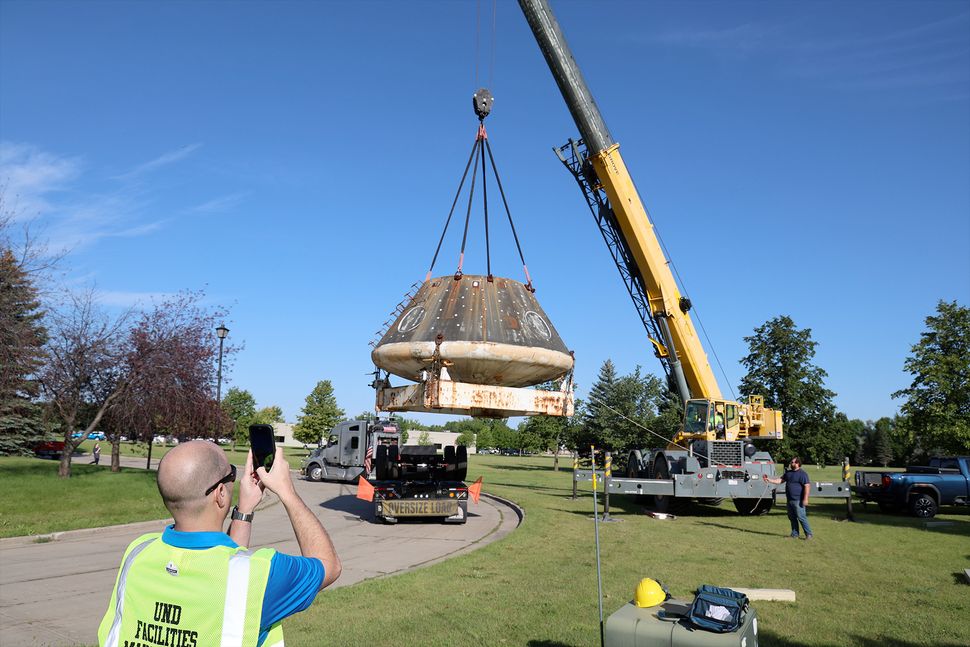A space capsule that NASA used to learn more about safely launching astronauts to the moon has arrived at a U.S. school for a different type of education.
The University of North Dakota (UND) has taken delivery of the Orion Max Launch Abort System (MLAS) test vehicle, which 15 years ago demonstrated one possible way of escaping a failing rocket. The mock spacecraft arrived Monday (Aug. 27), after a week-long, 30-state road trip that began at the Langley Research Center in Virginia and ended in Grand Forks.
“The fact is, we are so far away from NASA centers, and we very seldom get pieces of historic significance. This is a major one,” said Pablo de León, chair of the space studies department at UND, in a statement.
On July 8, 2009, the full-size Orion capsule, encased in a bullet-shaped fairing, leapt off the ground at NASA’s Wallops Flight Facility in Virginia. Climbing approximately one mile high (1.6 km), the uncrewed Orion rode atop the thrust from four solid rocket motors that were mounted to a skirt at the bottom of the 33-foot-tall (10 m) vehicle.
Simulating an emergency on the launch pad, the “pad abort” test ended in just under a minute with the mock crew module separating from its boost skirt and deploying parachutes to splash down in the Atlantic Ocean. Although NASA had already selected a different type of escape system to use with Orion, the MLAS demo was the first to conduct a full-scale fairing separation and contributed to the development of the spacecraft’s parachutes.

Now no longer needed, NASA released the MLAS capsule to UND after de León spent several months pursuing it for the school. It is now one of only a few Orion mockups and spacecraft on (or heading to) public display, including the Exploration Flight Test-1 (EFT-1) vehicle at the Kennedy Space Center Visitor Complex in Florida and the Artemis I capsule, which will go on exhibit in 2026 at the National Air and Space Museum in Washington, DC.
At UND, de León plans to use the Orion MLAS as a teaching tool, showing students how it bridges NASA’s past and future. First, though, the capsule needs to be cleaned.
De León and his graduate students intend to sandblast and restore the 18,000-pound (8,200 kg) capsule to its original paint scheme, while retaining its original, still visible NASA logo. The artifact may also be suffering from saltwater damage, given that it was submerged in the ocean, so they will have a look inside.
“NASA built it to be a weight simulator of the capsule. Chances are, it’s just metal,” de León said of the mockup’s interior.
Once restored, the capsule may be moved from where it was delivered, next to department’s Inflatable Lunar-Mars Analog Habitat, to a more visible location on the campus so it can be visited by public school students from across the region. De León is hoping to provide students with additional information about the MLAS and how it is relevant to NASA’s current effort to return humans to the moon.
“We are seeing if we can, with the help of NASA, get a kind of a documentary produced on the capsule’s flight and why it’s important for the Artemis program, so kids can learn about the history of it and why it’s important for the future,” he said.
De León is also looking to acquire more artifacts to be used along with the capsule as instructional tools. He has already an Apollo-era Saturn I rocket engine, which is currently be refurbished for display.
Follow collectSPACE.com on Facebook and on Twitter at @collectSPACE. Copyright 2024 collectSPACE.com. All rights reserved.